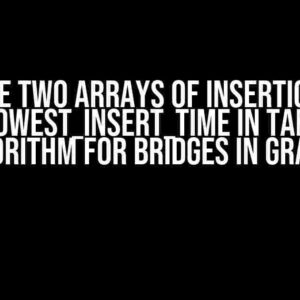Are you tired of manually calculating powers of tens in your code? Do you find yourself rewriting the same logic over and over again? Well, fear no more! In this article, we’ll show you how to create a reusable function to calculate powers of tens using a loop, and how to reuse it in another query.
What is the Power of Tens?
The power of tens refers to the result of raising 10 to a given exponent. For example, 10^2 is equal to 100, and 10^3 is equal to 1000. Calculating powers of tens is a common operation in programming, especially in mathematical and scientific applications.
Why Use a Function?
There are several reasons why you should use a function to calculate powers of tens:
- Code Reusability: By creating a reusable function, you can avoid rewriting the same logic multiple times in your code.
- Efficiency: Using a function can make your code more efficient, as you can reuse the same calculation logic without having to rewrite it.
- Readability: A well-named function can make your code more readable, as it clearly indicates what the function does.
Creating the Function
To create a function to calculate powers of tens, you can use the following code:
function calculatePowerOfTen(exponent) {
let result = 1;
for (let i = 0; i < exponent; i++) {
result *= 10;
}
return result;
}
This function takes a single argument, `exponent`, which is the power to which 10 should be raised. The function uses a `for` loop to repeatedly multiply the result by 10, and returns the final result.
How Does the Function Work?
The function works by using a `for` loop to repeatedly multiply the result by 10. The loop runs `exponent` times, and each time it multiplies the result by 10. For example, if you call the function with an exponent of 2, the loop will run twice, multiplying the result by 10 each time:
| Iteration | Result |
|---|---|
| 1 | 1 * 10 = 10 |
| 2 | 10 * 10 = 100 |
The final result is then returned by the function.
Reusing the Function
Now that we have created the function, let’s see how we can reuse it in another query. Suppose we want to calculate the area of a rectangle with a width of 5 and a length of 10^2.
const width = 5;
const length = calculatePowerOfTen(2);
const area = width * length;
console.log(area); // Output: 500
In this example, we call the `calculatePowerOfTen` function with an exponent of 2, which returns the value 100. We then use this value to calculate the area of the rectangle.
Benefits of Reusing the Function
By reusing the `calculatePowerOfTen` function, we can avoid rewriting the same logic multiple times in our code. This has several benefits:
- Reduced Code Duplication: We avoid duplicating code, which makes our code more maintainable and easier to read.
- Improved Efficiency: We can reuse the same logic without having to rewrite it, which makes our code more efficient.
- Enhanced Readability: By using a well-named function, we can clearly indicate what the code is doing, making it easier to understand.
Conclusion
In this article, we’ve shown you how to create a reusable function to calculate powers of tens using a loop, and how to reuse it in another query. By using a function, we can avoid code duplication, improve efficiency, and enhance readability. Remember to always consider reusing code whenever possible, and to use clear and descriptive names for your functions.
Additional Resources
If you want to learn more about functions and loops in programming, here are some additional resources:
By following these resources, you can learn more about functions and loops in JavaScript, and how to use them to create more efficient and readable code.
Frequently Asked Question
Here are some frequently asked questions about creating a function to calculate power of tens with a loop and reusing them in another query.
What is the purpose of creating a function to calculate power of tens with a loop?
The purpose of creating a function to calculate power of tens with a loop is to efficiently compute and store the powers of tens in an array, which can be reused in other parts of the program or in different queries, reducing code duplication and improving performance.
How can I implement a function to calculate power of tens with a loop in a programming language?
You can implement a function to calculate power of tens with a loop by using a for loop or while loop to iterate from 0 to a specified maximum power, and within the loop, calculate the power of ten using the exponentiation operator (e.g. `Math.pow(10, i)` in JavaScript) and store the result in an array.
Can I reuse the calculated powers of tens in another query or part of the program?
Yes, once you have calculated and stored the powers of tens in an array, you can reuse them in another query or part of the program by simply accessing the array elements, eliminating the need to recalculate the powers of tens.
What are the benefits of using a function to calculate power of tens with a loop?
The benefits of using a function to calculate power of tens with a loop include improved code readability, reduced code duplication, and enhanced performance, as well as the ability to easily maintain and update the function if needed.
Can I use this approach for calculating other mathematical series, such as powers of twos?
Yes, this approach can be applied to calculate other mathematical series, such as powers of twos, by simply modifying the base value (e.g. from 10 to 2) and using the same loop and exponentiation operator.





![Demystifying the Mysterious Error: “args and kwargs – got multiple values for argument” [ duplicate ] Demystifying the Mysterious Error: “args and kwargs – got multiple values for argument” [ duplicate ]](https://armida.hkhazo.biz.id/wp-content/uploads/sites/126/2024/07/demystifying-the-mysterious-error-args-and-kwargs-got-multiple-values-for-argument-duplicate-with-text-300x300.jpg)